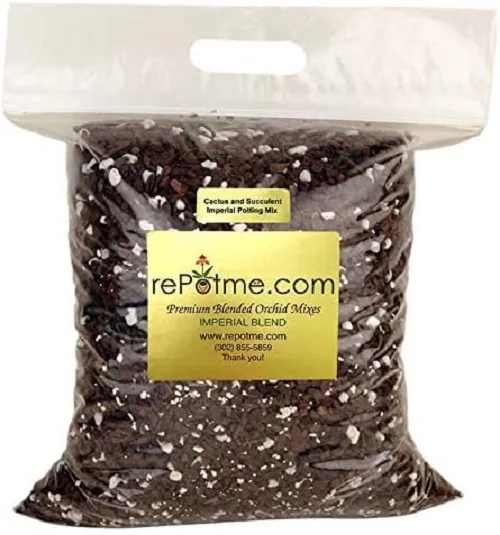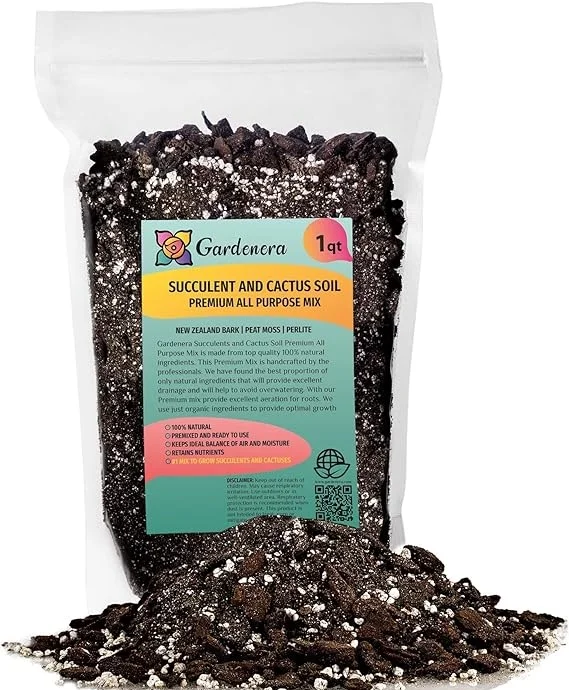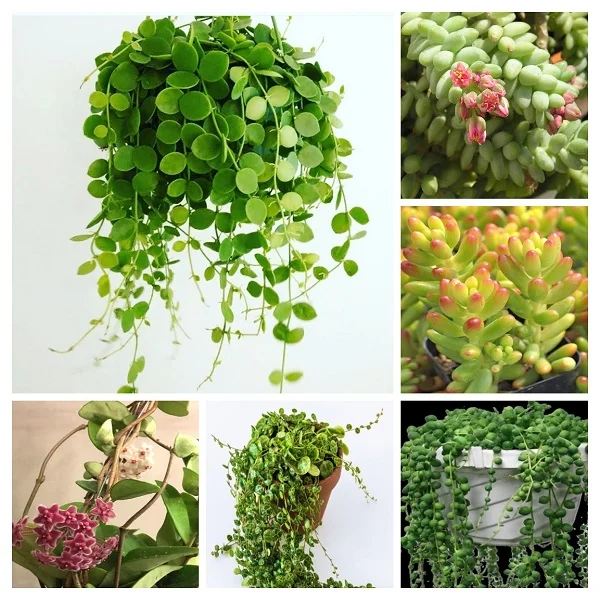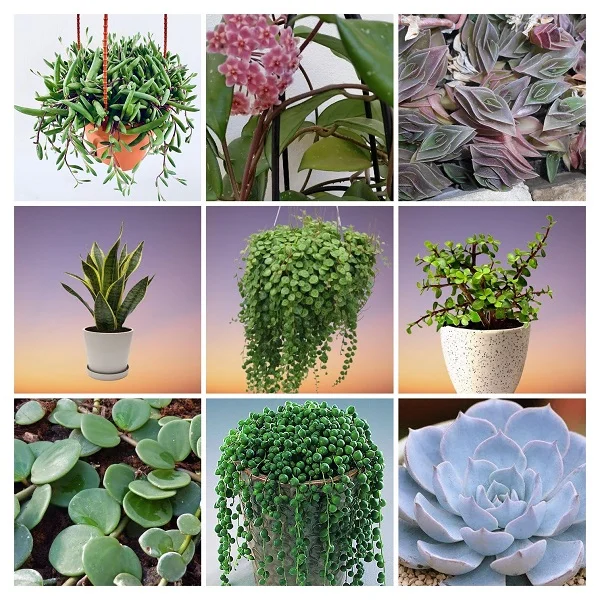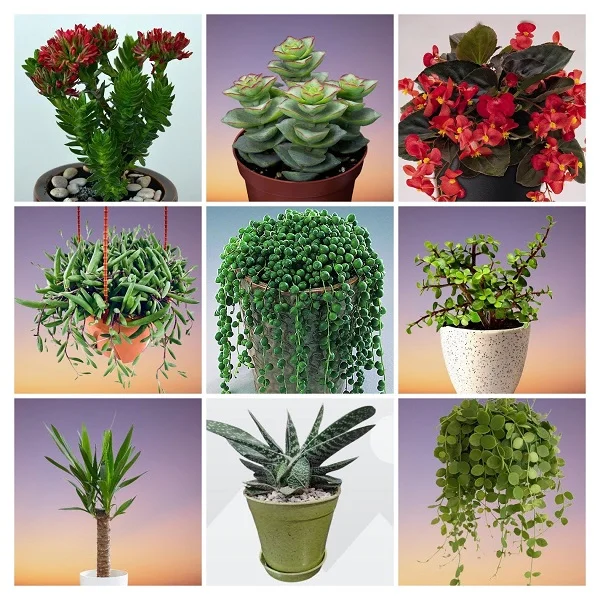String of Pearls Plant (Senecio rowleyanus) Indoor Care, Propagation and Growing Problems
Some links in this post may be affiliate links
String of Beads Plant (Senecio rowleyanus) blossoms in bright light with some direct sunlight, moderate warmth, average humidity and moderately moist, rich, well-drained, succulents soil coupled with monthly feeding in the growing season.
Senecio rowleyanus also called String of Beads Plant is among the popular Senecio varieties with pendant thread-like stems on which spherical, green leaves grow making it resemble a neck-lace of beads or pearls, hence the common names.
The odd shaped leaves is an adaptation to arid conditions and allows for the storage of water while exposing minimum surface area to the dry desert air which greatly reduces water loss.
The fleshy leaves and stems store water, which allows the String of Beads Plant to go for a considerably long period without being watered. It is one of the best plants with low water needs.
Each leaf bears a translucent window that runs the length of the leaf which allows light to reach into interior of the leaf where photosynthesis takes place.
In its natural habitat, String of Pearls Plant grows as a trailer, with stems trailing on the ground, rooting where they touch and forming dense mats which places it among the popular string of plants ideal for growing indoors.
This growth habit makes it perfect for a hanging basket, pedestal, tabletop, desktop or shelf where the stems can beautifully cascade downwards. String of Beads Plant is one of the favorite plants for a hanging basket.
On account of its low maintenance, versatility and magnificent foliage, String of Beads Plant is among the most popular plants for the home. It is almost certain to find at least one in most homes.
String of Pearls Plant was named after the British Botanist, Gordon Douglas Rowley who specialized in Cactaceae and succulents.
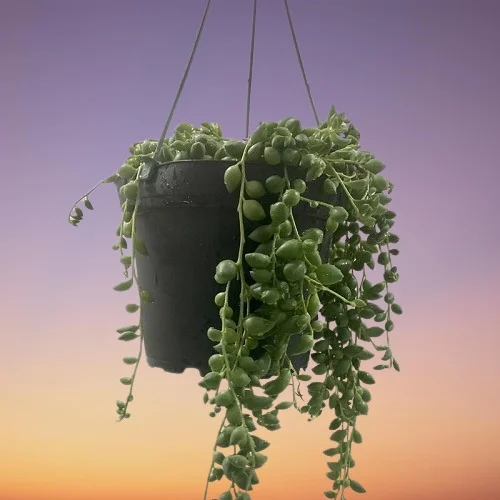
Botanical name: Senecio rowleyanus
Synonmy: Curio rowleyanus
Family: Asteraceae
Common names: String of Pearls Plant, String of Beads Plant
Origin
Senecio rowleyanus also called Curio rowleyanus is a creeping, perennial, succulent vine native to the drier parts of Southwest Africa where it grows in the shaded conditions under other plants and rocks.
Toxicity
The foliage of String of Beads Plant like other Senecio species is toxic to humans and pets as outlined by ASPCA. If ingested, it can cause drooling, vomiting, diarrhea and lethargy. Contact with the plant sap may cause skin irritation or skin rash in sensitive skin therefore, always wear gloves when handling the plant. Keep it away from the reach of children and pets to avoid mishaps.
Where to Buy
If you are looking to acquire the beautiful String of Beads Plants for your collection, they are available online on Amazon (Link to Amazon).
Senecio rowleyanus Care Indoors
String of Beads Plant (Senecio rowleyanus) flourishes in bright light with 6-8 hours of direct sunlight, moderate warmth of 20-270C, average humidity of 50-55% and moderately moist, fertile, well-drained, succulents soil coupled with monthly feeding during the growing season.
String of Pearls Plant requires pruning to keep the plant neat, to reduce pest and disease infestations and rejuvenate growth. Repotting is only needed when the plant has become root-bound. Keep reading for more on these growing conditions and how to achieve them.
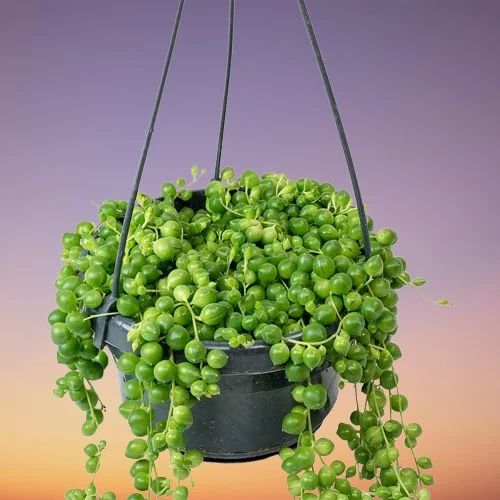
Light Requirements
String of Beads Plant grows best in bright light with at least 6-8 hours of direct sunlight per day. Protect it from hot midday sunshine to avoid scorching and loss of leaf color.
Where the natural lighting is not sufficient, consider growing the plant under grow lights as too little light may result in legginess. Check out these full spectrum grow lights on Amazon.
Regularly turn the pot to ensure that the plant receives light on all sides for uniform growth as well as prevent leggy growth and leaf drop.
Watering
Water String of Beads Plant liberally during the growing season while allowing the top 2-3 inches of soil to dry out between waterings to maintain the soil moderately moist.
Decrease watering during the cold period to maintain the soil barely moist but do not allow the soil to dry out completely as it can lead to wilting and leaf drop.
Confirm that the pot has a drainage hole inorder to prevent the soil from getting soggy as it can lead in rotting and eventual death of the plant.
Temperature and Humidity
Average warmth of 20-270C is ideal for String of Pearls Plant. A room temperature that is comfortable for you is ideal for this plant. Keep it away from drafts as it does not like sudden changes in the temperature.
String of Beads Plant has no need for high humidity. Average room humidity of 50-55% is ideal for this plant. Ensure that there is good air circulation to prevent fungal disease infestations.
Feeding
Feed String of Pearls Plant monthly during the growing season with a balanced, liquid fertilizer. This plant is not a heavy feeder so be careful when feeding.
Withhold feeding in the cold season as growth is minimal at this time and feeding at this time can cause fertilizer burn and eventual death of the plant.
Potting Mix
The best soil for String of Pearls Plant should be rich in organic matter, loose and free-draining to avoid getting soggy soil. The soil should be loose enough to allow water to drain out fast enough. Cactus and succulents soil is ideal for this plant as it drains easily.
Repotting
Senecio rowleyanus has a small root system so frequent repotting is not necessary. Repot it at the beginning of the growing season only when it becomes crowded in its current pot.
Use a pot that is only 1 size larger and one that has a drainage hole to prevent the soil from getting soggy as it can lead to rotting. Use a shallow pot and be careful not to bury the stems of the String of Pearls Plant to prevent rotting. Take a look at these succulents pots available on Amazon.
Pruning
Pruning String of Beads Plant involves removal of any dead Beads or stems to keep the plant neat and also reduce pest and disease infestations. Trim the stems if they become too long or straggly to rejuvenate growth.
Propagation
String of Pearls Plant (Senecio rowleyanus) propagation can be done at the beginning of the growing season from stem cuttings.
How to propagate String of Beads Plant from stem cuttings
Take 3-5 inches stem cuttings from a healthy String of Beads Plant and allow the cuttings to dry (callus) for about 7 days.
Lay the stems on moist free-draining soil and lightly press the stems into the soil at the nodes.
Place the set up in a warm, well-lit place and maintain the soil moist until the stems are rooted.
Allow substancial growth before transplanting the new Curio rowleyanus after which you can begin routine care.
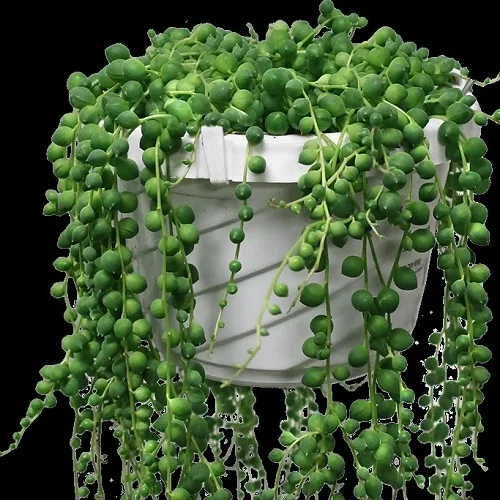
Senecio rowleyanus Problems with Solutions
String of Pearls Plant (Senecio rowleyanus) problems include leaf drop, leggy growth, leaf spots, rotting, plant death, pests and diseases among others. Keep reading for more on these problems and how to fix them.
Brown, soft leaf spots
Brown, soft leaf spots in String of Beads Plant are an indication of leaf spot disease. Avoid wetting the leaves and improve air circulation to prevent disease infestations.
Diseases
String of Pearls Plant is prone to powdery mildew. Isolate the affected plant to prevent spread to other plants and treat it for the disease.
Rotting base, stem collapse
Rotting plant base and stems collapse in String of Beads Plant is an indication of basal stem rot disease which is brought about by overwet conditions. Use the upper healthy stems to propagate new plants and discard the infected parts to reduce spread to the rest of the plant.
Thereafter, water the plant liberally during the growing season while allowing the top 2-3 inches of the soil to dry out between waterings. Significantly reduce watering during the cold season to maintain the soil barely moist as growth is minimal at this time.
Pests
The common pests in String of Beads Plant are spider mites, scales and mealy bugs. Isolate the affected plant to prevent spread to the rest of the plants and treat it appropriately for the pests. Learn how to identify and get rid of pests in houseplants.
Leggy growth (elongated stems)
Leggy growth (elongated stems) in String of Pearls Plant during the cold season is due to too much water (overwatering) or soggy soil. Water the plant less during the cold season to maintain the soil barely moist and ensure that the pot has a drainage hole to prevent the soil from getting soggy.
If leggy growth (elongated stems) happens during the growing season, then the cause is too little light. Move the plant to a brighter spot and ensure it receives bright light with 6-8 hours of direct sunlight or instal a grow light if the natural light is inadequate.
In addition, turn the pot regularly to ensure that the plant receives light on all sides for uniform growth. Check out this article on understanding light for houseplants.
Brown dry spots
Brown dry spots in String of Beads Plant are due to underwatering resulting in too little moisture in the soil. Water the plant moderately during the hot season while while allowing the top 2-3 inches of the soil to dry out between waterings. Significantly decrease watering during the cold period to maintain the soil barely moist as growth is reduced at this time. Learn more on how to water indoor plants the right way.
Sudden leaf drop
There are two possible causes on sudden leaf drop in String of Pearls Plant. One possible cause of sudden leaf drop is watering with very cold water. Being a tropical plant where temperatures are warm, watering with too cold water will shock the plant. Water the plant with water that is at room temperature to avoid shocking it.
The second possible cause of sudden leaf drop in Senecio rowleyanus is underwatering. Water the plant liberally and allow the soil to dry out slightly between waterings but never allow the soil ball to dry out completely.
Wilted and discolored leaves
Wilted and discolored leaves in String of Beads Plant are caused by overwatering during the cold period. Reduce watering during the cold season and maintain the soil barely moist.
You liked it? Share on social media.
Related Content
Amazon Associates Disclosure
Homeplantsguide.com is a participant in the Amazon Services LLC Associates Program, an affiliate advertising program designed to provide a means for sites to earn advertising fees by advertising and linking to amazon.com.
